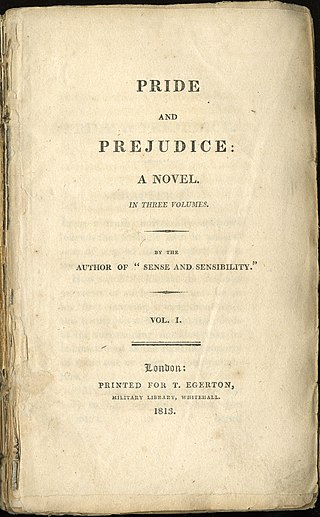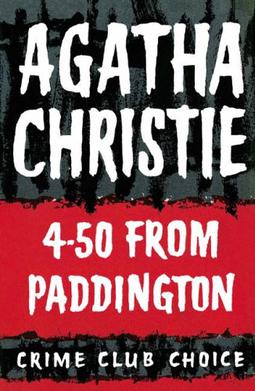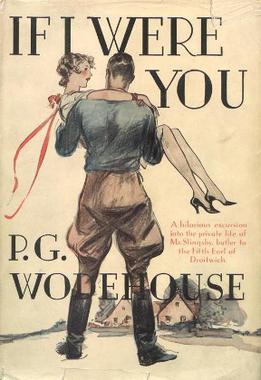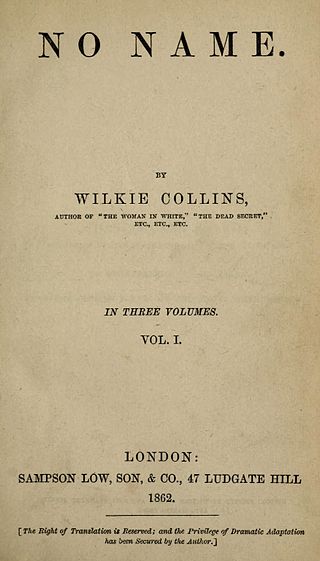Plot summary
In the German spa town of Wildbad, the 'Scotchman' Mr. Neal is asked to transcribe the deathbed confession of Allan Armadale; his story concerns his murder of the man he had disinherited (also called Allan Armadale), who had subsequently married the woman he was betrothed to under false pretensions. Under Allan's instructions, the confession is left to be opened by his son once he comes of age.
Nineteen years later, the son of the murdered man, also Allan Armadale, rescues a man of his own age, Ozias Midwinter. The stranger reveals himself to Reverend Decimus Brock, a friend of Allan through his late mother, as another Allan Armadale (the son of the man who committed the murder). Ozias tells Decimus of his desperate upbringing, having run away from his mother and stepfather (Mr. Neal). The Reverend promises not to disclose their relation to one another, and the young men become close companions. Ozias remains haunted by a fear that he will harm Allan as a result of their proximity, a fate warned of in his father's letter; this feeling intensifies when the pair spend a night on a shipwreck off the Isle of Man—as it turns out, the very ship on which the murder was committed. Also on the vessel, Allan has a mysterious dream involving three characters; Ozias believes that the events are a prophecy of the future.
Three members of Allan's family die in mysterious circumstances, one of which was instigated with the rescue of a woman who attempted to commit suicide by drowning. As a result, Allan inherits the estate of Thorpe-Ambrose in Norfolk and relocates there with Ozias, intending to make him steward. Once there he falls in love with Eleanor (Neelie) Milroy, the sixteen-year-old daughter of Major Milroy, to whom he has rented a cottage. During this time, correspondence takes place between Maria Oldershaw and Lydia Gwilt concerning the latter's ambitions to marry Allan as a means of achieving retribution for his family's apparent wrongdoings (she was originally a maid in the service of his mother).
Lydia, who is 35 but looks 20-something, is the villain of the novel and her colourful portrayal takes up much of the rest of the story. Originally Allan's mother's maid, and a contributor to the conflict between Allan and Ozias's fathers, she is a fortune hunter and, it turns out, a murderess. Unable to alienate Allan's affections from Miss Milroy, she settles for marrying Midwinter, having discovered his name is the same. She plots to murder Allan, or have him killed by her ex-lover, a Cuban desperado and, since she is now "Mrs. Armadale," to impersonate his widow. Allan escapes the desperado's attempt on his life—he is supposed to have drowned in a shipwreck—and returns to England. Lydia's plans are thus foiled. Her last shot is to murder Allan herself—the weapon being poison gas, the scene being a sanatorium run by a quack called Doctor Downward—but she is thwarted by her own conscience. Midwinter and Allan have switched rooms, and she can't bring herself to murder her true husband, for whom she does have genuine feelings of love. After rescuing Midwinter and writing him a farewell note, she goes into the air-poisoned room and kills herself. Allan marries Miss Milroy; Midwinter, still his best friend, becomes a writer.
Some linking passages consist of letters between the various characters, or of extracts from Lydia's journal, but the great majority of the text narrates the events as they occur. The novel is enlivened by many minor characters including Mr Bashwood, an old failure of a clerk who is infatuated with the beautiful Lydia; his son, James 'Jemmy' Bashwood, a private detective; Mrs Oldershaw, an unscrupulous associate of Lydia's; the Pedgifts (father and son), Allan's lawyers; and the Rev Decimus Brock, a shrewd (but not quite shrewd enough) clergyman who brings Allan up but who is kept out of the way for much of the book.
Adaptations
In the same year that it finished its serial publication, Collins wrote a dramatic version of Armadale in order to protect his rights to later stage the novel.
A play by Jeffrey Hatcher based on the novel premiered on 23 April 2008 at the Milwaukee Repertory Theater.
BBC Radio 4 broadcast a three-part adaptation by Robin Brooks of the novel between Sunday 7 and Sunday 21 June 2009. The cast was Lydia, Lucy Robinson; Allan, Alex Robertson; Midwinter, Ray Fearon; Neelie, Perdita Avery; Bashwood, Richard Durden; Downward, Geoffrey Whitehead; James 'Jemmy' Bashwood, Grant Gillespie; Vincent, Robin Brooks.
In this adaptation, Lydia Gwilt is the narrator, and her character is emphasised rather than Midwinter's forebodings.

Pride and Prejudice is the second novel by English author Jane Austen, published in 1813. A novel of manners, it follows the character development of Elizabeth Bennet, the protagonist of the book, who learns about the repercussions of hasty judgments and comes to appreciate the difference between superficial goodness and actual goodness.

William Wilkie Collins was an English novelist and playwright known especially for The Woman in White (1859), a mystery novel and early sensation novel, and for The Moonstone (1868), which established many of the ground rules of the modern detective novel and is also perhaps the earliest clear example of the police procedural genre.

Sleeping Murder: Miss Marple's Last Case is a work of detective fiction by Agatha Christie and first published in the UK by the Collins Crime Club in October 1976 and in the US by Dodd, Mead and Company later in the same year. The UK edition retailed for £3.50 and the US edition for $7.95.

After the Funeral is a work of detective fiction by Agatha Christie and first published in the US by Dodd, Mead and Company in March 1953 under the title of Funerals are Fatal and in UK by the Collins Crime Club on 18 May of the same year under Christie's original title. The US edition retailed at $2.50 and the UK edition at ten shillings and sixpence (10/6).

The Moving Finger is a detective novel by British writer Agatha Christie, first published in the USA by Dodd, Mead and Company in July 1942 and in the UK by the Collins Crime Club in June 1943. The US edition retailed at $2.00 and the UK edition at seven shillings and sixpence.

Elephants Can Remember is a work of detective fiction by British writer Agatha Christie, first published in 1972. It features her Belgian detective Hercule Poirot and the recurring character Ariadne Oliver. This was the last novel to feature either character, although it was succeeded by Curtain: Poirot's Last Case, which had been written in the early 1940s but was published last. Elephants Can Remember concentrates on memory and oral testimony.

Murder Is Easy is a detective fiction novel by Agatha Christie first published in the UK by the Collins Crime Club in June 1939, and in the US by Dodd, Mead and Company in September the same year under the title Easy to Kill. Christie's Superintendent Battle has a cameo appearance at the end, but plays no part in either the solution of the mystery or the apprehension of the criminal. The UK edition retailed at seven shillings and sixpence (7/6), and the US edition at $2.

A Pocket Full of Rye is a work of detective fiction by Agatha Christie and first published in the UK by the Collins Crime Club on 9 November 1953, and in the US by Dodd, Mead & Co. the following year. The UK edition retailed at ten shillings and sixpence (10/6) and the US edition at $2.75. The book features her detective Miss Marple.

4.50 from Paddington is a detective fiction novel by Agatha Christie, first published in November 1957 in the United Kingdom by Collins Crime Club. This work was published in the United States at the same time as What Mrs. McGillicuddy Saw!, by Dodd, Mead. The novel was published in serial form before the book was released in each nation, and under different titles. The US edition retailed at $2.95.

The Pale Horse is a work of detective fiction by British writer Agatha Christie, first published in the UK by the Collins Crime Club on 6 November 1961, and in the US by Dodd, Mead and Company the following year. The UK edition retailed at fifteen shillings and the US edition at $3.75. The novel features her novelist detective Ariadne Oliver as a minor character, and reflects in tone the supernatural novels of Dennis Wheatley who was then at the height of his popularity. The Pale Horse is mentioned in Revelation 6:8, where it is ridden by Death.

The Clocks is a work of detective fiction by British writer Agatha Christie, first published in the UK by the Collins Crime Club on 7 November 1963 and in the US by Dodd, Mead and Company the following year. It features the Belgian detective Hercule Poirot. The UK edition retailed at sixteen shillings (16/-) and the US edition at $4.50.

Bleak House is a fifteen-part BBC television drama serial adaptation of the Charles Dickens novel of the same name, which was originally published in 1852–53 as itself a print serialisation over 20 months. Produced with an all-star cast, the serial was shown on BBC One from 27 October to 16 December 2005, and drew much critical and popular praise. It has been reported that the total cost of the production was in the region of £8 million.

If I Were You is a novel by P. G. Wodehouse, first published in the United States on 3 September 1931 by Doubleday, Doran, New York, and in the United Kingdom on 25 September 1931 by Herbert Jenkins, London.

No Name is a novel by Wilkie Collins, first published in 1862. Illegitimacy is a major theme of the novel. It was originally serialised in Charles Dickens' magazine All the Year Round before book publication. It is the second of his four 'great novels' after The Woman in White (1860), and before Armadale (1866) and The Moonstone (1868).
Lydia is a feminine first name. It derives from the Greek Λυδία, Ludía, from λυδία, a feminine form of the ancient given name Λυδός (Lydus). The region of Lydia is said to be named for a king named Λυδός; the given name Lydia originally indicated ancestry or residence in the region of Lydia.

The Bennet family is a fictional family created by the English novelist Jane Austen in her 1813 novel Pride and Prejudice. The family consists of Mr and Mrs Bennet and their five daughters: Jane, Mary, Catherine, Lydia, and Elizabeth, who is the novel's protagonist.
Hide and Seek is Wilkie Collins' third published novel, first published on 6 June 1854. It is the first of his novels involving the solution of a mystery, the elements of which are clearer to the reader than to the novel's characters. Suspense is created from the reader's uncertainty as to which characters will find out the truth, when and how.
The Dead Secret is a novel published by Wilkie Collins, first in 1857 as a series in Charles Dickens' Household Words weekly magazine and later the same year as a book.
The Adventures of a Donkey is a British children's circulation novel written in 1815 by Arabella Argus, author of other children's novel such as Ostentation and Liberality, The Juvenile Spectator and The Further Adventures of Jemmy Donkey. The story follows young Jemmy donkey's life. It is narrated by Jemmy himself, thus, is full of self-evaluation and growth; it also shows an interesting insight into the life of a nineteenth century working animal.
















